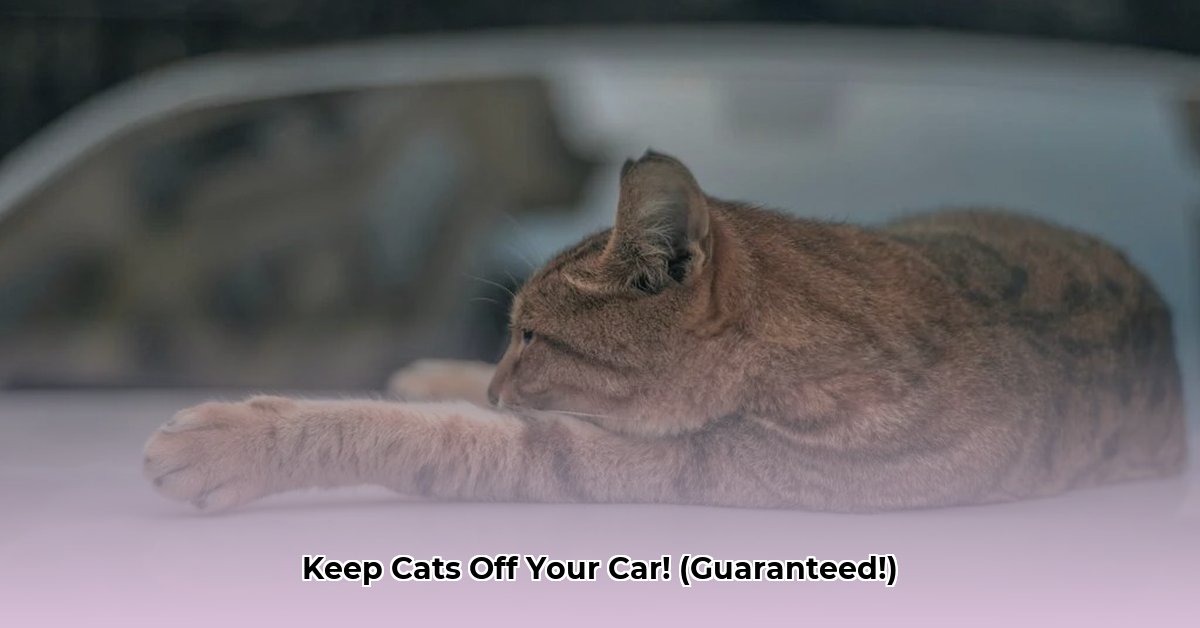Dealing with a cat that treats your car like a personal playground? Whether it’s your own furry friend or a neighborhood visitor, this guide offers practical solutions to reclaim your vehicle. From simple repellents to high-tech gadgets, we’ll cover everything you need to know to send cats packing (nicely, of course!).
Repellents: A Cat’s Least Favorite Scents
Repellents disrupt a cat’s attraction to your car, encouraging them to find another spot to hang out.
- Commercial Sprays: Convenient and readily available, but check labels for safety and test on a small, hidden area of your car first. Effectiveness can vary.
- DIY Mixtures: Vinegar, citrus peels, and essential oils (like rosemary and lavender) can deter cats. Mix with water and test on a small area before widespread use.
- Powders: Generally inexpensive, but messy and easily washed away by rain. Effectiveness can be inconsistent.
- Natural Deterrents: Scattering citrus peels or dried herbs (rosemary, lavender) around your parking spot may help. Be cautious, as some herbs are toxic to pets and children. Research thoroughly before use.
- Cayenne Pepper: Sprinkle around your car (not directly on it) to create a spicy, invisible barrier.
Devices: High-Tech Cat Deterrents
For a more technological approach, consider these devices:
- Ultrasonic Repellents: Emit high-frequency sounds annoying to cats but usually inaudible to humans. Check the device’s range and be aware that some may affect other animals.
- Motion-Activated Sprinklers: Give trespassing cats an unexpected shower. Remember to turn them off before approaching your own car!
- Motion-Activated Lights & Sounds: Startle cats with sudden bursts of light or noise, but be mindful of potential neighborly disturbances.
Physical Barriers: Shielding Your Ride
Create a physical obstacle between your car and feline offenders:
- Car Covers: Provide full-body protection. Choose a breathable cover to prevent moisture buildup.
- Cat Spike Mats: Plastic spikes create an uncomfortable surface for cats without causing injury. Exercise caution during placement to avoid scratching your car’s paint.
Environmental Changes: Making Your Car Less Appealing
Modifying your car’s surroundings can deter cats:
- Relocate Your Parking Spot: Park in a garage, shaded area, or any spot less enticing to cats. Even a slight change in location can make a difference.
- Eliminate Food Sources: Secure garbage cans, clean up dropped food, and avoid leaving pet food outside.
If It’s Your Cat…
If your own cat is the culprit, try these solutions:
- Nail Trimming: Regular trims minimize potential damage.
- Alternative Resting Spots: Provide comfy beds, sunny window perches, or cat trees to make these spots more appealing than your car.
- Training: Use a spray bottle filled with plain water as a humane deterrent. Be patient and consistent.
If It’s a Neighbor’s Cat…
- Communicate Respectfully: Talk to your neighbor, explain the situation, and suggest possible solutions. They may be unaware of their cat’s behavior.
Troubleshooting: For Persistent Felines
If cats are still a problem:
- Combine Methods: Use a combination of repellents, devices, and environmental modifications for maximum effectiveness.
- Persistence: Keep trying different strategies. What works for one cat may not work for another.
Why Cats Love Cars
Understanding why cats are drawn to cars can help you choose the most effective deterrent. Several factors might be at play:
- Warmth: A recently driven engine provides a cozy spot, especially in colder weather.
- Height: The hood or roof offers a vantage point to survey their surroundings.
- Texture: Tires offer a satisfying scratching surface, allowing cats to mark their territory.
- Security: Nooks and crannies under the car offer safe, hidden spaces.
Quick Reference Table: Cat Deterrent Cheat Sheet
| Method | Likely Effectiveness | Estimated Cost | Safety Level |
|---|---|---|---|
| Commercial Sprays | Moderate | Low-Moderate | Check Labels |
| Homemade Sprays | Moderate | Low | Generally Safe |
| Powders | Low-Moderate | Low | Generally Safe |
| Natural Deterrents | Low-Moderate | Low | Varies |
| Cayenne Pepper | Moderate | Low | Generally Safe |
| Car Covers | High | Moderate-High | High |
| Cat Spike Mats | Moderate-High | Moderate | High |
| Ultrasonic Repellents | Varies | Moderate | High |
| Motion-Activated Sprinklers | High | Moderate | High |
| Motion-Activated Lights/Sounds | Moderate | Moderate | High |
| Environmental Modifications | Moderate-High | Low | High |
| Training (Own Cat) | Moderate-High | Low | High |
| Talking to Neighbors | Varies | N/A | N/A |
This table provides a quick overview, but remember that effectiveness can vary depending on the individual cat and the specific circumstances. Further research into feline behavior and deterrents is ongoing, so stay informed about new developments. With a bit of patience and persistence, you’ll likely find a solution that works for you.
- Weight Loss Supplements That Work and Those That Dont - October 31, 2025
- Male Eating Disorders Often Missed but Increasingly Prevalent - October 29, 2025
- Males With Anorexia Nervosa Have Distinct Symptoms and Treatment Needs - October 28, 2025










